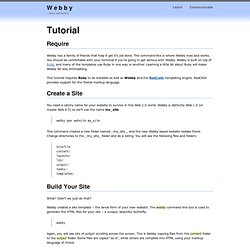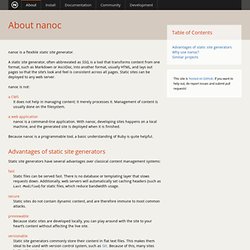

Static Website Generators Reviewed: Jekyll, Middleman, Roots, Hugo. Advertisement Many companies try to create a great experience for customers.

But few are willing to make the changes required to deliver on that promise. In fact most don’t even realize just how bad their experience can be. This is why we made a new book called “User Experience Revolution,” a practical battle plan for placing the user at the heart of your company. Get the book now! Static site generators are quickly becoming a big part of the professional website builder’s toolbox. In the last article1, I looked at why static website generation is growing in popularity, and I gave a high-level overview of all of the components of a modern generator. Further Reading on SmashingMag: Link In this article, we’ll look at four popular static website generators — Jekyll, Middleman, Roots, Hugo — in far more detail.
Each generator takes a repository with plain-text files, runs one or more compilation phases, and spits out a folder with a static website that can be hosted anywhere. Jekyll Link. Static Website Generators Reviewed: Jekyll, Middleman, Roots, Hugo. Hugo Future Imperfect. Introduction This tutorial will show you how to create a simple theme in Hugo.

I assume that you are familiar with HTML, the bash command line, and that you are comfortable using Markdown to format content. I’ll explain how Hugo uses templates and how you can organize your templates to create a theme. I won’t cover using CSS to style your theme. We’ll start with creating a new site with a very basic template. In this tutorial, commands that you enter will start with the “$” prompt. Here’s an example: ## this is a comment $ echo this is a command this is a command ## edit the file $vi foo.md +++ date = "2014-09-28" title = "creating a new theme" +++ bah and humbug :wq ## show it $ cat foo.md +++ date = "2014-09-28" title = "creating a new theme" +++ bah and humbug $ Some Definitions There are a few concepts that you need to understand before creating a theme.
Skins Skins are the files responsible for the look and feel of your site. Static Site Generators. Static Site Generators. Docpad, Jekyll, Pelican… Les générateurs de sites statiques. Une présentation des générateurs de sites statiques que nous avons dans le radar, que nous utilisons ou que nous avons utilisé.

Nous vous demandions il y a quelque temps si vous étiez plutôt site statique ou dynamique et je me suis dit que autant les CMS sont connus de tous, autant les générateurs de sites statiques, excepté peut-être Jekyll, le sont nettement moins. Il est temps de réparer cette erreur et de vous présenter une compilation de mes préférés sur les 213 recensés dans le genre. J’ai choisi des projets Open Source bien maintenus par de nombreux contributeurs. Top Open-Source Static Site Generators - StaticGen. Docpad, Jekyll, Pelican… Les générateurs de sites statiques. Top Open-Source Static Site Generators - StaticGen. Harp, le générateur de sites statiques avec préprocesseurs embarqués. Découvrez Harp, un static site generator construit sur Node.js qui prend en charge pour vous toute la panoplie des préprocesseurs les plus fréquents.

Un générateur de site statique ? Connaissez-vous les générateurs de sites statiques ? Ces CMS ont pour avantage de pouvoir s’héberger n'importe ou, même sur drop box ! Leur secret ? Comme le nom l'indique, ils génèrent un site "statique" en html/css/javascript, sans aucun langage serveur ni base de données nécessaire. De cette manière, votre serveur n'a qu'à servir à vos visiteurs un site statique, sans plus de travail. Pour plus d'exemples, je vous propose de lire ces quelques articles : Découvrez JR, un generateur de site (vraiment) statiqueFaire un blog sans Wordpress ?
Overview — Sphinx 1.1.3 documentation. Blogofile. Cyrax 0.1.5. Package Index > cyrax > 0.1.5 Not Logged In Status Nothing to report.

Tutorial. Require Webby has a family of friends that help it get it’s job done.

The command-line is where Webby lives and works. You should be comfortable with your terminal if you’re going to get serious with Webby. Webby is built on top of Ruby, and many of the templates use Ruby in one way or another. Learning a little bit about Ruby will make Webby far less intimidating. This tutorial requires Ruby to be installed as well as Webby and the RedCloth templating engine. About nanoc. Nanoc is a flexible static site generator.

A static site generator, often abbreviated as SSG, is a tool that transforms content from one format, such as Markdown or AsciiDoc, into another format, usually HTML, and lays out pages so that the site’s look and feel is consistent across all pages. Static sites can be deployed to any web server. nanoc is not: a CMS It does not help in managing content; it merely processes it. Webgen - static website generator. Hyde - A Python Static Website Generator.